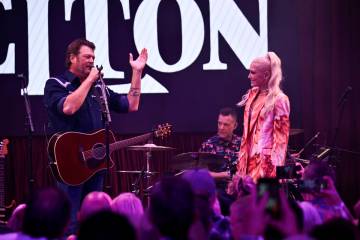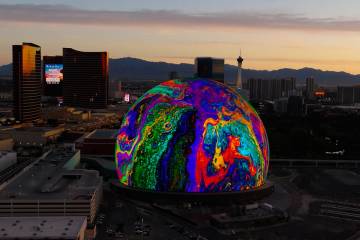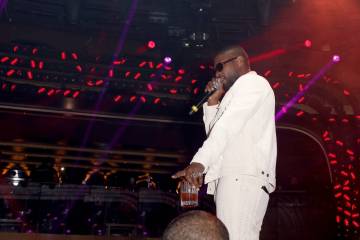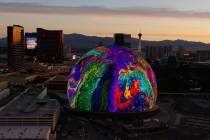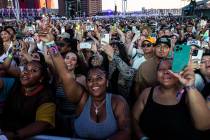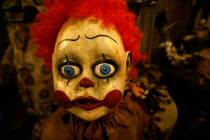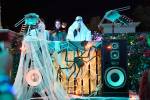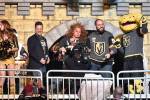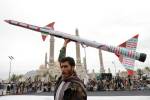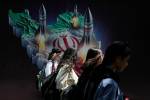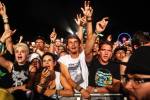‘Building Atomic Vegas’ charts parallel rise of Las Vegas and Nevada Test Site
Big, bulbous, goes boom. Or did.
Called the B-53 "Gravity Bomb," marked "Status: Retired." One would hope so.
Across the way stands a cutout of Elvis Presley, billed in his first Vegas go-round as "The Atomic-Powered Singer."
He bombed.
Nevada Test Site rising over here. Entertainment Capital of the World rising over there. Born and raised, more or less, together.
Think of it biblically: Atom enjoying Original Sin (City).
"A lot of the people and the money that flowed into the test site built Las Vegas into what it is today," says Allan Palmer, executive director of the Atomic Testing Museum, hosting the "Building Atomic Vegas" exhibit into early next year. "We thought it was a neat story to tell."
Colorful wiseguys and infamous Vegas mack daddy Bugsy Siegel notwithstanding, the city burgeoned in the 1940s as atomic bomb research scientists and staff streamed into the region, helping to transform it from a dusty outpost to a simmering cauldron of, well, sin.
Party-hearty even then, Las Vegans gathered at casinos that threw bomb blast viewing shindigs, also luring tourists so crucial to the city's growth. They would wolf down Atomic Burgers. Lap up Atomic Cocktails. Send their duds to the Atomic Cleaners. Paste the mushroom cloud image on everything from marquees and billboards to newspaper ads and high-school yearbooks.
"From 1951 all the way to 1992, when the last nuclear test was done, there could be 10,000 people all at one time working there," says Aaron Warkentin, the museum's education coordinator. "At the time we were pushing the bounds of science we were also pushing the bounds of society. We wanted to bring all that together to show they have meaning."
Passing through an entrance marked by a 7-foot mushroom cloud -- built by the theater department at the University of Nevada, Las Vegas -- "Building Atomic Vegas" pinballs you between the site and the Strip, science and pop culture.
Exhibits range from site artifacts (glowing yellow sculpture from glass used during production of plutonium) and documents (correspondence detailing Howard Hughes' criticism of atomic testing and concern that radiation was getting into the water supply) to movie posters ("Creature with the Atom Brain" starring Richard Denning, "Dig That Uranium" featuring the Bowery Boys) and an oil painting ("Doomtown: Mannequins in the Desert," depicting the figures falling over as a bomb explodes).
"One of the things I find interesting about Las Vegas is how academic it used to be," says Las Vegan Sunni Westbrook as she tours the displays. "We had some of the great scientists and great minds of the day. That's what brought people here in the first place, and everything else kind of grew up around them."
Screens play video interviews of witnesses and workers, including one woman recalling how a blast blew the doors of her home open, frightening her young son. "It's only an atomic bomb," she reassured him. "It won't hurt you."
Another mines the memories of ex-test site employee Doug Atkins, who rejected criticism of the site. "Some say people were killed at the test site," he says onscreen. "Well, yes, but we were involved in a war. It was the Cold War, but it was a war. We felt very good to get the job done, and we won. And after we won, we ended up without jobs."
Elsewhere, a photo of President John F. Kennedy arriving to inspect the site provides a perfect bridge to the Strip -- where his brother-in-law, Peter Lawford, was carousing with the Rat Pack.
Meanwhile, a reproduction of an Apollo spacesuit -- courtesy of Palmer's ex-employer, the San Diego Air and Space Museum -- reflects how the site's usefulness stretched to the cosmos.
"Gene Kranz, the former flight director for NASA, and his geologists, as they started getting ready to go to the moon, practiced at the site," Palmer says.
"It has big craters that look like the moon, and the soil samples turned out pretty close to the moon's surface. They drove the lunar rovers to practice. This was Buzz Aldrin and Neil Armstrong and all the guys. It was a pretty big deal."
Numerous artifacts, Palmer says, come from the collection of ex-lieutenant governor Lonnie Hammargren, including a huge Riviera hotel sign and the motorcycle manned by Robbie Knievel for his 1989 jump over the Caesars Palace fountains. Also included: Knievel's suit, the backside in tatters from what, presumably, wasn't a gentle landing.
Site maps are mounted across from cutouts of protestors toting banners: "Ban the Bomb" and "Make Art, Not Bombs." A Liberace display case spotlights a candelabra, rings and ruffled tux across from photos detailing 1970s hotel openings, including the Hilton, MGM Grand and Imperial Palace -- juxtaposed against the story of radioactive materials accidentally released in 1970.
"Sometimes it's a little too technical, but mostly I found it interesting," says John Swilley, visiting from Orlando, Fla. "I have a healthy respect for nuclear systems. I don't feel it's a threat right now, but there are all these terrorist organizations. They only have to get lucky once."
One section is partially enclosed by the reproduction of a bomb shelter's cinder block walls. "I'm a kid of the '50s and '60s, going through the civil defense drills," says Ron Caudillo of San Diego.
"I thought the tests were just to see if the thing would go boom, but so many exhibits talk about taking scientific measurements in the milliseconds before. Seeing a camera with a shutter speed of a millionth of a second was astounding."
Demonstrating that the destructive power of the bomb had a constructive effect on a city that grew to global prominence, the exhibit highlights this Benny Binion quote:
"The best thing to happen to Las Vegas was the atomic bomb."
Controversial as its creation will always be, it did -- in the best sense -- make a city go boom.
Contact reporter Steve Bornfeld at sbornfeld@ reviewjournal.com or 702-383-0256.
Preview
"Building Atomic Vegas"
10 a.m.-5 p.m. Mondays-Saturdays;
noon-5 p.m. Sundays (through Jan. 5)
Atomic Testing Museum, Frank H. Rogers Building, 755 E. Flamingo Road
$9-$12 (794-5151;
www.atomictestingmuseum.org)






